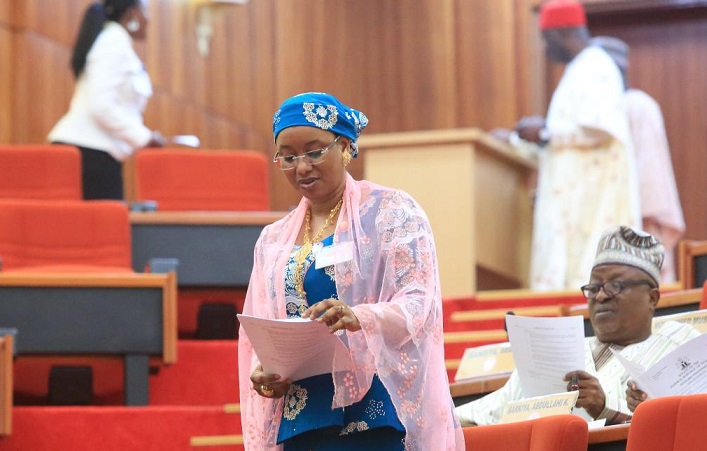Speaking at the senate plenary session, Senator Aishatu Dahiru, representing Mubi Central, and Senator Seriake Dickson, representing Bayelsa West, recently made claims on Nigeria’s population figures and land mass. Here is a fact check of two of their claims:
Claim one: Senator Dahiru claimed the population of Mubi North was higher than the entire Bayelsa State. Senator Dickson, who was a former governor of Bayelsa State, disagreed.
- What next after CBN’s intervention in poultry sector?
- Harden ‘feels like the MVP’ after Nets beat Pistons
Claim two: Senator Dickson claimed that the size of Bayelsa – physical landmass and water bodies – was three times bigger than some states in Nigeria.
VERDICT: False. Senator Dahiru’s claim that the population of Mubi North was higher than that of the entire Bayelsa State is false. The claim is not supported by the 2006 population census data from the National Population Commission (NPC) or the population estimates published by the National Bureau of Statistics (NBS). Similarly, Senator Dickson’s claim that the size of Bayelsa was three times bigger than some states in Nigeria is false. Records from the Office of the Surveyor-General do not support the claim.
Full Text
Presenting a recent bill on the need to establish a Federal Medical Centre in Mubi during a plenary session, Senator Dahiru compared the Mubi North Local Government Area and Bayelsa State in terms of population.
She said Mubi, with a total landmass of 506.4km2, was bigger than Bayelsa State’s eight local government areas with a population of 1,704,515.
She said Mubi has a population of 759,045, which together with the population of Mubi North (a local government area headquartered in Mubi) makes it 2,089,540 people (very much higher than Bayelsa State’s eight local government areas, with a population of 1,704,515).
But how true is Senator Dahiru’s claim that the population of Mubi North, including Mubi town, is higher than the population of Bayelsa State as a whole?
Meanwhile, in countering Senator Dahiru’s claim, Senator Dickson also declaimed that figures presented by Senator Dahiru were not verifiable.
The former governor claimed that the size of Bayelsa, the physical land mass and the water bodies, was thrice bigger than some states in the country.
“In my senatorial district, it will take me four days to go round. In my local government, Sagbama, it will take me three days to go round,” he said.
But how true is Senator Dickson’s claim that Bayelsa is three times bigger than some states in Nigeria.
Verification
Nigeria’s official population figures are outdated considering that the last national census was conducted in 2006, being 15 years ago.
However, being the only authentic data for Nigeria’s population, the figures were consulted to verify the claim.
Census data sourced from the NPC showed that as at 2006, the population of Bayelsa was 1,704,515.
Conversely, the NPC declared the population of Mubi North as 151,072 people as of the 2006 census.
It is worth noting that population estimates were also consulted to verify the claim.
The NBS published population estimates in its Annual Abstract of Statistics for both states and local government areas.
The 2011 Annual Abstract of Statistics published by the NBS showed that while the estimated population of Mubi North in 2010 was 170,151, that of the entire Bayelsa State was 1,914,764.
The latest NBS’ Annual Abstract of Statistics, published in 2017, dropped population estimates for local government areas.
Therefore, both the 2006 census data and the population estimates published by the NBS in 2011 (being the latest for population estimates by local government areas) showed that the population of Bayelsa State is bigger than that of Mubi North.
On the second claim, data from the Office of the Surveyor-General showed that Bayelsa State occupies a total area (both land mass and water bodies) of 9,059 square kilometres (km2), measuring 905,900 hectares, 2,228,514 acres and 3,538.67 square miles.
Analysis of Area of Nigeria segregated by states by the Surveyor-General showed that Bayelsa State is bigger than nine states in Nigeria and the Federal Capital Territory (FCT), Abuja.
The states include Abia (4,900km2), Akwa Ibom (6,900km2) Anambra (4,865km2), Ebonyi (6,400km2), Ekiti (5,435km2), Enugu (7,534km2), Imo (5,288km2), Lagos (3,671km2), Osun (9,026km2) and the FCT (7,607km2).
For Bayelsa State to be three times bigger than a state, the state must occupy an area less than 3,020km2 (that is, the 9,059km2 area which the state occupies divided by three).
Records from the Office of the Surveyor-General published by the NBS in its latest Annual Abstract of Statistics in 2017 show that no state in Nigeria occupies an area less than 3,020km2.
Conclusion
Senator Dahiru’s claim that the population of Mubi North was higher than that of the entire Bayelsa State is false. The claim is not supported by data from the National Population Commission or the National Bureau of Statistics. Both the 2006 census data and population estimates published by the NBS showed that the population of Bayelsa State is bigger than that of Mubi North. Similarly, Senator Dickson’s claim that the size of Bayelsa was three times bigger than some states in Nigeria is false. Records from the Office of the Surveyor-General do not support the claim.

 Join Daily Trust WhatsApp Community For Quick Access To News and Happenings Around You.
Join Daily Trust WhatsApp Community For Quick Access To News and Happenings Around You.

